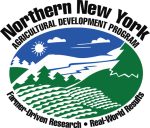
June 11, 2024. The farmer-driven Northern New York Agricultural Development Program has posted the second-year results of its Value of Manure project, a regional research project contributing to a statewide effort to update New York’s manure value crediting system. The research considers how advances in nutrition, new manure treatment systems, and overall farm management have impacted manure composition and nutrient availability to corn silage and grain crops.
“Our research is evaluating the nutrient value of different types of manure sources beyond those common at the time the original manure crediting system was developed. We also evaluate the yield and forage quality benefits that manure may have beyond what can be obtained using just inorganic fertilizer to manage the crops” says Quirine M. Ketterings, Ph.D., Director of the Cornell Nutrient Management Spear Program.
Manure contains nitrogen (N) in organic and inorganic forms. Organic N becomes plant-available over time; inorganic N is already crop-available and can be lost when manure is surface-applied or applied when the crop cannot benefit from it. Both types of scenarios are being evaluated.
The project is also looking at how variable manure nutrient composition is between farms, storages on farms and days within a spreading interval. The research group sampled 16 manure sources from five farms in northern NY. The results showed that farm-specific manure management greatly impacted nutrient composition.

A Tale of Two Farms
The NNYADP Value of Manure research project results showed silage yield and silage quality benefited from spring-applied manure at the two trial locations in NNY in 2023. Manure was applied to three strips, and three strips were left without manure application in each location. Then, each strip (manured and not manured) was subdivided into 6 subplots, and each subplot received a different N sidedress rate.
At Farm A, 10,370 gallons/acre of dairy liquid manure were injected in April. Farm B broadcasted 30 tons/acre of solid dairy manure. Sidedress N fertilizer was applied to six subplots at Farm A at rates from 0 to 175 lbs N/acre and at Farm B at rates from 0 to 200 lbs N/acre.
Most economical rate of N (MERN) was calculated to identify the N rate that would give the maximum economic return for manured and non-manured scenarios. The calculation used a fertilizer price of 73 cents per pound of N, and a $55/ton silage value at 35% dry matter (DM).
For Farm A, the MERN was 109 lbs N/acre when no manure was applied versus 0 lbs N/acre where manure had been applied. The silage yield at the MERN was 24.3 tons/acre with manure applied versus 22.9 tons/acre without manure. When no sidedress was applied to zero-N fertilizer subplots, the average silage yield in the manured plots was 4.2 tons/acre higher than when no manure was applied.
For Farm A, the economic yield at the MERN, not including the cost of application, was $1,137/acre with manure versus $986/acre without manure.
For Farm B, the MERN was 56 lbs N/acre when no manure was applied versus 113 lbs N/acre. where manure had been applied. The increase in fertilizer N reflected a very large increase in yield. When no sidedress was applied to zero-N fertilizer subplots, the average yield in the manured plots was 4.6 tons/acre higher than when no manure was applied. At the MERN, the yield was 17.1 tons/acre when manure was applied versus 12.5 tons/acre without manure.
For Farm B, the return at the MERN, not including the cost of application, was $658/acre when manure was applied versus $449/acre without manure.
Impact on Forage Nutrients
Manure application at Farm A increased forage potassium, calcium, magnesium, and copper in the silage. Crude protein, phosphorus, potassium, and copper contents were lower in the lower N sidedress plots than in the higher-rate subplots. At Farm B, manure application increased forage soluble protein, neutral detergent fiber, and manganese concentrations. Crude protein and soluble protein contents were lower when less N was sidedressed.
This research continues in 2024 with a new grant from the farmer-driven NNYADP. Project collaborators include Champlain Valley Agronomics, Peru, NY; W.H. Miner Agricultural Research Institute, Chazy, NY; and Cornell PRO-DAIRY, Ithaca, NY.
Complete results from the NNYADP Value of Manure trials in 2022 and 2023 are posted at nnyagdev.org under About: Projects by Year. Statewide project results are summarized on the What’s Cropping Up? Cornell Field Crops blog.
Funding for the Northern New York Agricultural Development Program is supported by the New York State Legislature through the New York State Assembly and administrated by the New York State Department of Agriculture and Markets.
